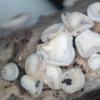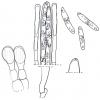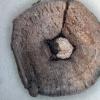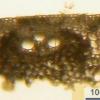
17-12-2025 18:35
 Michel Hairaud
Michel Hairaud
Bonjour à tous/Hi to everyone I am passing along

15-12-2025 15:48
 Danny Newman
Danny Newman
Melanospora cf. lagenaria on old, rotting, fallen

15-12-2025 15:54
 Johan Boonefaes
Johan Boonefaes
Unknown anamorph found on the ground in coastal sa

15-12-2025 21:11
 Hardware Tony
Hardware Tony
Small clavate hairs, negative croziers and IKI bb

15-12-2025 07:09
 Danny Newman
Danny Newman
indet. Rutstroemiaceae sp. on unk. fallen leavesMc

15-12-2025 07:05
 Danny Newman
Danny Newman
Pseudosclerococcum golindoi (det: Zotto)near Cosb

15-12-2025 11:49
 Danny Newman
Danny Newman
ITS sequences from the following two collections B

15-12-2025 12:34
 Danny Newman
Danny Newman
indet. Rhytismataceae on oak leafnear Purchase Roa
Calycina sp. 2
Nicolas VAN VOOREN,
31-10-2009 18:43
 Encore un Calycina (je pense), récolté sur tige morte de roseau
Encore un Calycina (je pense), récolté sur tige morte de roseauApothécies courtement stipitées, cupuliformes peu profondes, hyménium blanc ou ivoire, surface externe concolore, finement pubérulente ; Ø 1-2.5 mm
Sous-hyménium de textura intricata ; excipulum de textura subglobulosa/angularis, à hyphes hyalines, d'où émergent des celules vésiculeuses contenant une grande vacuole réfringente.
Asques 80-108 x 6-7 µm, avec crochet, 8 sp. bisériées, pars spor. 38-48 µm, anneau apical IKI rb. Paraphyses avec une grande vacuole sommitale réfringente. Spores 15-18 x (2) 2.2-3 µm, avec une cloison (y compris dans l'asque), contenant plusieurs guttules.
Je n'ai pas réussi à trouver un nom. Une idée ?
Hans-Otto Baral,
31-10-2009 21:20

Re:Calycina sp. 2
Ups, this is also subherbarum.... I saw that you wrote in your other find that paraphyses are without VBs. Are you sure? Or maybe they were dead?
Is roseau = Rosa?
Zotto
Is roseau = Rosa?
Zotto
Alain GARDIENNET,
31-10-2009 22:23
Re:Calycina sp. 2
Roseau = Phragmites.
Here, I suppose it is Phragmites communis, isn't it Nicolas ?
(In French, Rosa are called "rosier" which gives "roses" as flowers).
Good night,
Alain
Here, I suppose it is Phragmites communis, isn't it Nicolas ?
(In French, Rosa are called "rosier" which gives "roses" as flowers).
Good night,
Alain
Nicolas VAN VOOREN,
01-11-2009 10:03

Re:Calycina sp. 2
Yes, that's right, it grows on dead stem of Phragmites. OK for C. subherbarum. I suppose this is a "working" name or is this name is published?
Hans-Otto Baral,
01-11-2009 12:37

Re:Calycina sp. 2
Yes, it's a working name. It's almost identical with herbarum but mainly differing in croziers, so one could philosophize if it is a separate species or not.
I almost forgot, however, that there is a Hymenosyphus subherbarum Raitv. & Sharma 1984, a somewhat dubious taxon which might be a Calycina too!
One question: a gramineous substrate would be the first time for this rather common taxon. The same is true for C. herbarum (without croziers) which I never saw on Monocots. So are you really sure with Phragmites? Is the stem round or somewhat angular in cross section? From a photo on a cross section this would become quite easily be clear.
Zotto
Zotto
I almost forgot, however, that there is a Hymenosyphus subherbarum Raitv. & Sharma 1984, a somewhat dubious taxon which might be a Calycina too!
One question: a gramineous substrate would be the first time for this rather common taxon. The same is true for C. herbarum (without croziers) which I never saw on Monocots. So are you really sure with Phragmites? Is the stem round or somewhat angular in cross section? From a photo on a cross section this would become quite easily be clear.
Zotto
Zotto
Nicolas VAN VOOREN,
01-11-2009 13:16
Hans-Otto Baral,
01-11-2009 17:18

Re:Calycina sp. 2
Hi Nicolas
I am actually sure that this is a dicot. The small central mark and the arrangement of the pores indicate that. Take a true Phragmites culm, I think it has a big lumen inside.
I recently took a photo of a cross section of a probably very thick culm of Phragmites from a Chinese collection. Here you see that the pores are arranged in groups near the culm surface.
Zotto
I am actually sure that this is a dicot. The small central mark and the arrangement of the pores indicate that. Take a true Phragmites culm, I think it has a big lumen inside.
I recently took a photo of a cross section of a probably very thick culm of Phragmites from a Chinese collection. Here you see that the pores are arranged in groups near the culm surface.
Zotto




